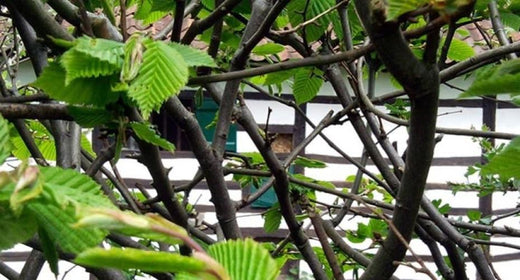Plant bare root soft fruit, hedging and trees in winter and early spring
Bare root trees, soft fruit and hedging are supplied without soil; they usually come wrapped in sacking. These plants are deciduous and are supplied when they are dormant and leafless in winter; usually between late October and March. Usually they are cheaper than container grown plants. Many of the soft fruits and hedging are supplied as a bundle of several plants so don’t leave these until they start growing before planting as the roots will start to grow together and can be damaged when separated. Bare root plants include: raspberries, blackberries, currants, mixed native hedging, beech, hornbeam and any young deciduous and fruit trees.
If you receive your plants in autumn and cannot plant until spring make sure that the roots are kept damp and frost free; the easiest way is to dig a hole and plant them, sacking and all, then dig them out when you are ready to plant. They are better planted in autumn as the soil still has some warmth in it and the plants can start to establish their root system. If the soil is waterlogged or frozen wait until the soil is just damp and the temperature warmer.
Preparation
Prepare the plants for planting by soaking in water for 30 minutes before-hand; this is especially important if you are planting bundles of hedging or soft fruit, as the roots may have become entwined and soaking will minimise any root damage.
Prepare the hole by digging it the same depth as the roots and 3 times the diameter. Loosen the sides of the hole with the fork to enable the new roots to penetrate easier. Mix the soil out of the hole with some organic matter, such as well-rotted farmyard manure, home-made compost or good quality peat-free compost from the garden centre.

Planting
If you are planting a large tree put in a stake before planting. Place the tree/plant in the hole to the same depth as it was previously planted; there is usually a mark around the stem, and spread out the roots in the hole. You can sprinkle in some natural mycorrhizal fungi, such as Rootgrow, to encourage root formation. Backfill around the plant with the soil/organic matter mixture taking care not to create any air pockets around the roots. Firm down and water. Don’t forget to protect the tree with a guard if there is a risk of damage from rabbits or deer. There is no need to add fertiliser at the planting stage.
Aftercare
Water well for the first year after planting, at least 4 – 6 cans a week in a dry spell, depending upon the size of the tree. Once the leaves start to wilt or go dry it has already sustained some damage. If you have applied mycorrhizal fungi when planting don’t feed with anything else in the first year as phosphorus in the fertiliser can prevent the fungi from doing its job. If you haven’t applied the fungi feed in spring with a balanced fertiliser such as blood, fish and bone or Growmore. Leave a bare circle of soil about 1m (40”) in diameter around the tree to remove any competition from weeds for water and nutrients. Keep this area weed-free by applying mulch, about 5cm (2”) thick, in spring; keep it 10cm (4”) away from the stem to avoid it rotting.
For more information, hints and tips on any aspect of gardening just get in touch with our Outdoor Plant team here in store.


